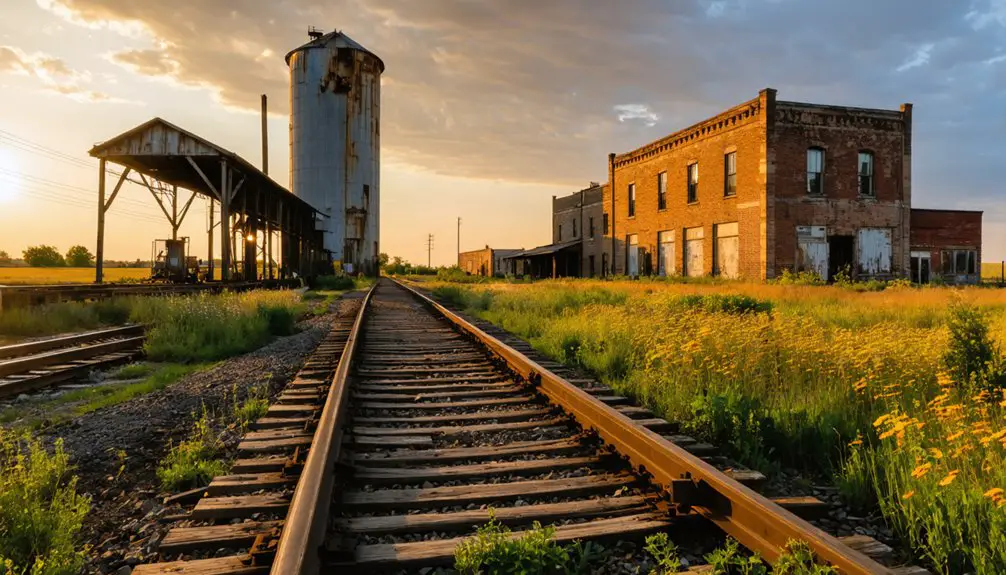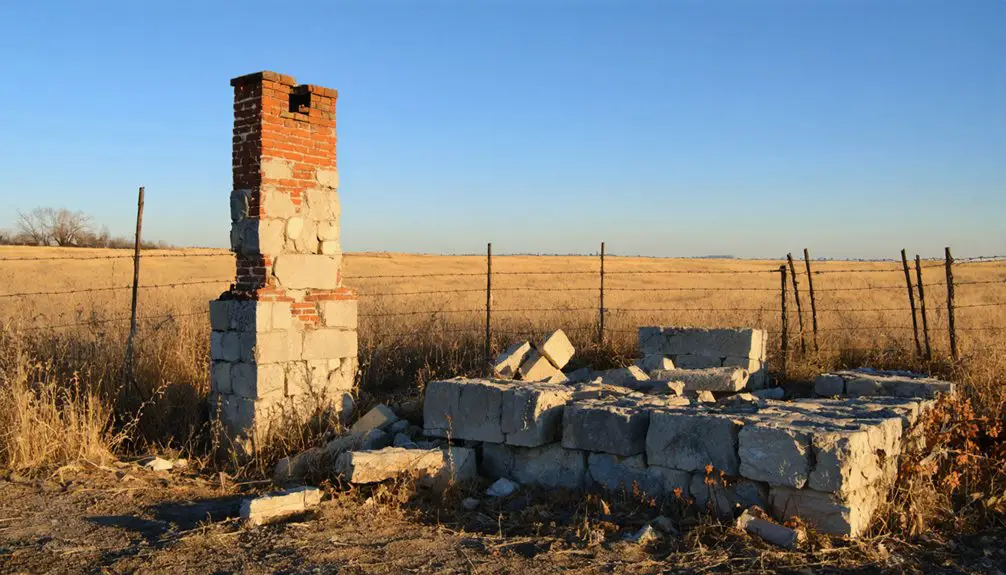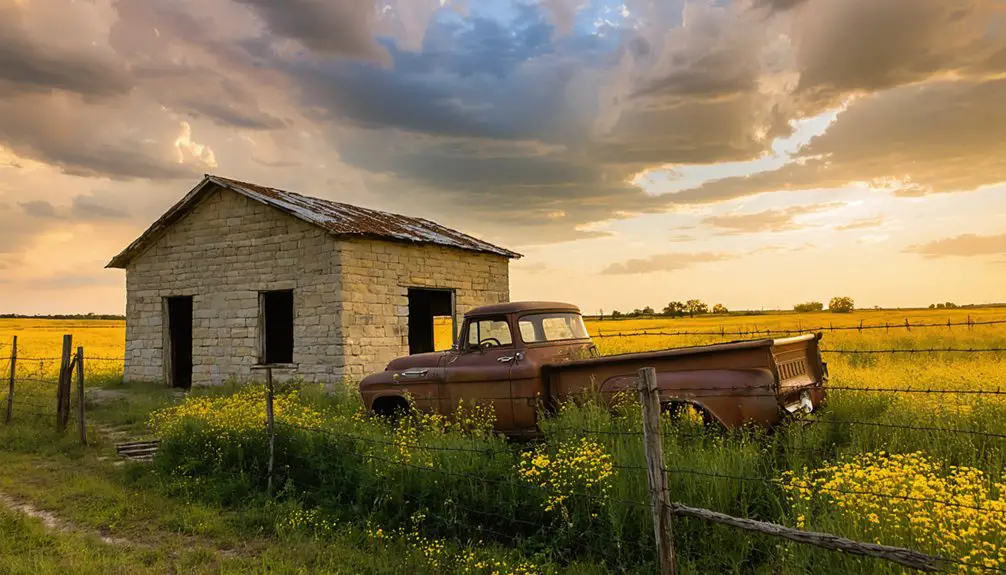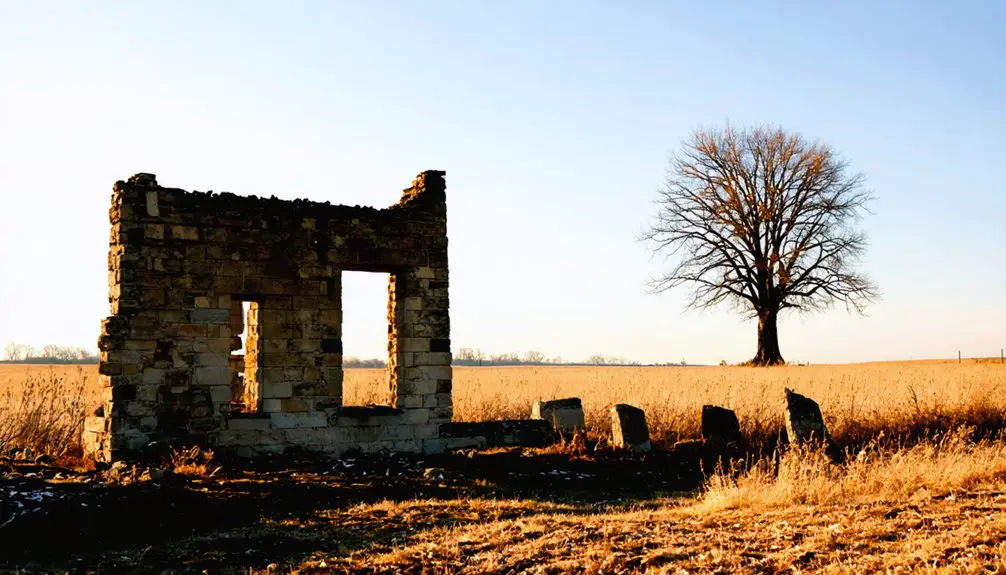You’ll find Waterloo’s ghost town remnants in Kansas, where A.B. Torrent established the first homestead in 1875. This pioneer settlement grew to 80-100 residents by the 1880s, with a post office and thriving Catholic parish. The town’s decline began when the railroad bypassed it in 1883, followed by losing the county seat battle. Today, weathered foundations and the historic Riggs Arboretum, founded in 1901, offer glimpses into Kansas’s frontier heritage.
Key Takeaways
- Waterloo began as an 1875 Kansas settlement established by A.B. Torrent, growing to 80-100 pioneers by the late 1880s.
- The town’s decline began when the railroad bypassed it in 1883, choosing nearby Murdock instead for its depot location.
- Waterloo lost its county seat status to Kingman, causing businesses to close and property values to plummet.
- The post office closure in 1912 marked the final chapter of Waterloo’s existence as an active community.
- Today, Waterloo serves as a ghost town tourist destination, preserving Kansas pioneer heritage through guided tours and historical markers.
Early Settlement and Trail Junction Origins
When A.B. Torrent settled along a small creek in 1875, he established the first foothold in what would become Waterloo’s settlement patterns.
You’ll find that many settlers followed from Illinois, fleeing floods and seeking fertile prairie land. By 1878, newcomers couldn’t claim free homesteads anymore – they’d to purchase their plots.
The area’s communication networks emerged when Simon F. Utley opened the post office in March 1878, running it from his dugout home alongside a stage station. Before gaining its permanent status, Waterloo served as the temporary county seat in 1857.
You’ll recognize this as a significant development that put Waterloo on the map. Though the settlement was initially called Stanford, it evolved into a transport hub connecting multiple trade routes.
Despite the harsh prairie winds and dust storms that drove some settlers away, many persevered, especially after L.M. Smith’s strategic planting of 12,000 trees. The Pleasant Valley Presbyterians established the first religious congregation in February 1878, strengthening the community’s foundations.
Rise to Village Status in the 1880s
During the 1880s, you’d find Waterloo emerging as a small but vibrant village with around 80 residents, supported by essential services like a schoolhouse, two churches, and various commercial establishments.
You could see the town’s formal recognition through its plat filing in 1879 and the official renaming of its post office from Stanford to Waterloo in 1881.
St. Louis Parish grew steadily as twenty Catholic families called Waterloo home by 1887.
While the town’s founders hoped to secure a railroad connection, the 1883 routing of tracks through nearby Murdock instead of Waterloo would greatly impact the settlement’s future growth potential.
Like many Kansas settlements of the era, Waterloo experienced significant challenges when agricultural prices collapsed, with corn prices falling drastically by 1890.
Early Pioneer Settlement
After A.B. Torrent established the first homestead in Galesburg Township in 1875, settlers from Illinois, including the Endicott family, followed his lead to escape flood conditions.
You’ll find that these early pioneers faced significant environmental challenges, battling persistent prairie winds and drought conditions that tested their resolve to stay.
Like other Kansas settlements of the era, Waterloo benefited from the presence of emigrant aid companies that helped support the establishment of essential community services.
Many settlers constructed log cabins without floors, similar to other early Kansas settlements of the 1850s.
The settlement, initially named Stanford before becoming Waterloo, gained its first post office in 1878 under Simon F. Utley, who operated a stage station from his dugout home.
Pioneer challenges included adapting basic shelters like dugouts and log cabins to harsh prairie conditions. A critical environmental adaptation came in 1879 when L.M. Smith planted 12,000 trees, creating essential windbreaks that transformed the landscape and made farming more viable for the growing community.
Railroad Junction Growth
Despite high expectations of becoming a railroad town, Waterloo’s trajectory changed dramatically when the railroad route bypassed the settlement in favor of Murdock, five miles to the south. The railroad importance became evident when Murdock’s depot opened in 1883, giving that community crucial shipping advantages that Waterloo couldn’t match.
You’ll find that transportation challenges severely impacted Waterloo’s growth potential during this period. The town’s post office operated until 1912, marking the end of an era for the settlement.
While the town managed to incorporate and establish essential services, including changing its post office name from Stanford to Waterloo in 1881, the lack of rail access hindered its commercial expansion. Later, the town faced another setback when it lost county seat status to Kingman.
The agricultural sector and Riggs nursery, which would’ve benefited greatly from railroad shipping, had to find alternative means to reach broader markets.
The Legacy of Riggs Arboretum
Founded in 1901 by John Walter Riggs, the Riggs Arboretum established itself as the oldest arboretum west of the Mississippi River and quickly became a pioneering center for experimental forestry.
You’ll find this remarkable site expanded from 10 to 35 acres by 1909, hosting over five million plants suited to regional conditions. Under the direction of Leslie D. Schrag, the arboretum continues its mission of preservation and education. The grounds feature a magnificent collection of state champion trees, including Yellowwood, Loblolly pine, and Laurel oak.
The arboretum’s commitment to conservation and plant education made it an essential resource for botanical research and urban development throughout Kansas.
- Rare species thrived here, including cedars of Lebanon, Palestine olives, and lotus from the Nile
- The arboretum supplied drought-resistant plants for Wichita’s parks and urban landscapes
- Despite Waterloo’s decline, the site remains a reflection of innovative forestry and botanical experimentation
Today, it stands as a preserved landmark of scientific achievement and natural heritage in Kingman County.
Loss of the County Seat Battle
You’ll find parallels between Waterloo’s fate and the bitter county seat battles that plagued Kansas towns like those in Gray County, where financial influence and political maneuvering often determined a community’s survival.
When Waterloo lost its bid to become the county seat, the devastating economic impact caused businesses to close and residents to abandon their properties in search of opportunities elsewhere.
The town’s ultimate transformation into a ghost town demonstrates how these heated political conflicts could seal the destiny of ambitious frontier communities, much like the fierce rivalry between Cimarron and Ingalls that ended in gunfire.
Political Battle Turns Bitter
While many Kansas towns faced fierce competition for county seat status, the battle over Gray County’s seat in 1887 turned particularly bitter as three towns – Montezuma, Ingalls, and Cimarron – vied for the coveted position.
Political alliances shifted dramatically when millionaire Asa T. Soule convinced Montezuma’s residents to back Ingalls instead, offering railroad construction and cash payments between $100-$500 per person.
Key developments in the election disputes that followed:
- Cimarron won the initial election but faced legal challenges
- The Kansas Supreme Court ordered records moved to Ingalls
- The conflict escalated into the violent Gray County War, culminating in the 1889 Cimarron gunfight
Despite court battles and bloodshed, Cimarron ultimately secured its position as county seat in 1893.
Economic Fallout Hits Hard
The brutal county seat wars left deep economic wounds in their wake, and Waterloo’s defeat marked the beginning of its rapid decline.
You’d have witnessed the town’s liveliness drain away as businesses dependent on county traffic shuttered their doors. Law offices, hotels, and merchants that once thrived on government activity struggled to survive the economic challenges.
Property values plummeted as residents moved away, seeking opportunities in the new county seat. The town’s infrastructure deteriorated while outside investment dried up.
Despite some community resilience, Waterloo couldn’t overcome the loss of its political importance. Transportation routes shifted, isolating the town further. Young workers left, leaving behind an aging population.
What remained was a shell of the once-prosperous hub, its empty buildings standing as silent witnesses to the devastating impact of losing the county seat battle.
Transportation Changes and Economic Impact

In 1883, Waterloo’s future dimmed markedly when it lost the essential race for a railroad depot to nearby Murdock, just five miles away.
Without critical transportation infrastructure, your town’s economic opportunities dwindled rapidly. The isolation intensified when Highway 54 bypassed Waterloo by half a mile, diverting significant traffic and commercial activity elsewhere.
A town without transport links is like a body without blood vessels – opportunities wither as isolation grows deeper.
Here’s what sealed Waterloo’s fate:
- Loss of railroad access forced businesses to relocate to better-connected towns
- Highway bypass eliminated important transient trade and business stops
- Limited shipping options crippled local agricultural producers’ ability to reach broader markets
The cumulative effect was devastating.
You’d have witnessed businesses and residents steadily moving toward Kingman and other areas with superior transport connections, ultimately leading to Waterloo’s ghost town status.
Pioneer Life on the Kansas Prairie
You’ll find pioneer life in Waterloo challenged settlers with harsh environmental conditions, including severe droughts that cracked the soil and dried wells during 1859-1860, while hot winds and jackrabbit infestations devastated their crops.
Your survival depended on building a shelter from available materials like sod, maintaining a self-sufficient homestead, and adapting to the treeless prairie landscape despite limited resources.
Through determination and cooperation, you’d work with neighboring families to establish vital community foundations – including one-room schoolhouses, churches, and farming cooperatives – which helped combat the intense isolation of prairie life.
Prairie Hardships and Challenges
Life on the Kansas prairie tested settlers’ resilience through unrelenting physical and emotional challenges. Your pioneer resilience would’ve been tested daily as you faced brutal weather extremes, from scorching 100-degree summers to devastating winter blizzards.
Environmental adaptation became essential to your survival, as you’d learn to use buffalo chips for fuel and build sod houses for shelter.
- You’d often find yourself completely isolated, with your nearest neighbors miles away and no immediate help during emergencies.
- You’d struggle with basic necessities, surviving on repetitive meals of cornbread and wild game while battling constant food scarcity.
- You’d face ongoing security threats, from territorial disputes to raids, without established law enforcement to protect your homestead.
Farming Against Nature’s Will
While prairie settlers faced intimidating environmental challenges, their farming innovations gradually tamed Kansas’ resistant landscape. You’d have found pioneers like John Riggs testing hardy plant varieties in his Waterloo nursery, which grew into a 35-acre experimental station with over five million plants by 1909.
Early farmers brought drought-resistant Turkey Red wheat, which thrived where other crops failed in the semi-arid climate. Breaking the stubborn prairie sod demanded intense labor – you’d spend all day with your ox team to clear just one acre.
But by 1918, the Waterloo Boy tractor revolutionized crop adaptation through mechanized farming. This shift from manual to machine power let you work faster and smarter, transforming the once-resistant prairie into productive farmland despite nature’s fierce resistance.
Building Community From Nothing
As A.B. Torrent staked his claim in 1875, you’d have witnessed the birth of a remarkable community rising from the untamed prairie.
Within three years, the settlement of Stanford (later Waterloo) demonstrated incredible community resilience through:
- Establishing essential infrastructure like Simon F. Utley’s post office and stage station operated from his dugout home
- Creating social cohesion through Pleasant Valley Presbyterian gatherings, initially in private homes
- Launching ambitious environmental projects, including L.M. Smith’s 12,000-tree forest initiative
You’d have found yourself among 80-100 pioneers by the late 1880s, sharing in what locals called “contagious prosperity.”
Despite harsh winds and dust challenges, settlers forged strong bonds through religious services, community events, and resource sharing.
This collaborative spirit transformed an isolated prairie outpost into a thriving settlement with multiple commercial buildings and social institutions.
Natural Heritage and Environmental Adaptation
Located on treeless, open prairie typical of 19th-century Kansas plains, Waterloo initially presented stark environmental challenges to its early settlers. Strong winds and dust clouds tested the settlers’ ecological resilience, forcing them to adapt their agricultural practices to the harsh conditions.
The untamed Kansas plains challenged settlers with fierce winds and swirling dust, demanding innovative solutions for survival on the harsh frontier.
You’ll find that natural conservation efforts transformed the landscape when L.M. Smith planted 12,000 trees in 1879. John Walter Riggs later established what became the oldest arboretum west of the Mississippi, growing to 35 acres with over 5 million plants by 1909.
This pioneering environmental initiative created essential windbreaks, improved soil retention, and introduced diverse species previously thought impossible to grow in Kansas.
The arboretum’s success demonstrated how determined settlers could reshape their environment while preserving natural heritage through scientific experimentation and community-driven stewardship.
Architectural Remnants and Historical Sites

Despite Waterloo’s ghost town status, several original buildings from the late 19th and early 20th centuries stand as evidence to its frontier heritage.
You’ll find architectural preservation efforts focused on documenting rather than restoring these structures, with historical documentation maintained in Kingman County archives. The Pleasant Valley Presbyterian Church, built in 1878, remains among the most significant remnants of this once-thriving settlement.
- Original dugout homes, including Simon F. Utley’s stage station and post office
- Stone foundations and wooden outbuildings scattered across former homesites
- Fourteen detailed historical maps marking building locations and old transportation routes
Today, you can explore these architectural remnants using preserved trail maps, though the town’s decline accelerated when Highway 54 bypassed it and the county seat moved to Kingman.
Role in Kansas Settlement Patterns
While many Kansas settlements emerged organically, Waterloo’s establishment in 1878 followed distinct migration patterns shaped by environmental pressures.
You’ll find that families fleeing floods in Illinois formed the core of early settlement dynamics, with A.B. Torrent leading the way in 1875. The town’s growth reflected broader demographic shifts occurring across Kansas, as settlers transformed treeless prairie into productive farmland.
L.M. Smith’s ambitious planting of 12,000 trees in 1879 exemplified settlers’ determination to reshape the harsh landscape.
Yet Waterloo’s story also demonstrates how external factors influenced settlement patterns – the loss of the county seat to Kingman and being bypassed by railroads led to the town’s decline.
Waterloo’s fate was sealed when it lost both the county seat and railroad connections, dooming its frontier dreams.
What began as a promising settlement of 100 residents ultimately succumbed to the competitive forces that determined many frontier towns’ fates.
Modern-Day Ghost Town Tourism

Today’s ghost town tourism in Waterloo showcases Kansas’s rich pioneer heritage, drawing history enthusiasts and photographers to its weathered remnants.
The site’s ghost town preservation efforts aim to protect authentic structures while allowing you to experience life from the Dust Bowl era. Tourism marketing initiatives have positioned Waterloo as an open-air museum of rural American history.
You’ll discover these compelling features:
- Historical plaques and guided tours revealing stories of farming community decline
- Photography opportunities among preserved architectural elements
- Seasonal heritage festivals celebrating pioneer culture
While you’re free to explore the ruins, you’ll find that tourism faces challenges from aging infrastructure and limited amenities.
Virtual tours and social media engagement are bringing new life to this historic site, though preservation concerns require careful visitor management to protect its authentic character.
Frequently Asked Questions
What Was the Peak Population of Waterloo During Its Most Prosperous Years?
Like a prairie wildfire spreading prosperity, the peak economy drove population growth to reach approximately 100 residents by 1895, expanding from its earlier count of around 80 pioneers seeking opportunity.
Were There Any Notable Crimes or Lawlessness Incidents in Waterloo’s History?
You won’t find any documented crime incidents or significant law enforcement activity in historical records. The town’s challenges centered on natural hardships and economic struggles rather than lawlessness or criminal behavior.
What Businesses and Services Existed in Waterloo Before It Became Abandoned?
You’d have found diverse business types from retail stores and banks to practical service offerings like a doctor, attorney, and blacksmith. There were also churches, schools, and a tree nursery.
Did Any Famous Historical Figures Ever Visit or Stay in Waterloo?
Like a blank page in history’s book, you won’t find any famous visitors in Waterloo’s story. The town’s historical significance came from local pioneers like Simon Utley and John Riggs instead.
How Many Original Buildings From Waterloo’s Prime Still Stand Today?
You won’t find detailed records of original structures still standing today. Historical preservation records don’t document exact numbers, though evidence suggests virtually all buildings from the town’s prime are gone.
References
- https://www.youtube.com/watch?v=Td_gmiDMfI4
- https://theactiveage.com/these-kansas-towns-didnt-stand-a-ghost-of-chance/
- http://kansasghosttowns.blogspot.com/2011/03/
- https://www.youtube.com/watch?v=PfThSLZOtqg
- https://legendsofkansas.com/kingman-county-extinct-towns/
- https://legendsofkansas.com/waterloo-kansas/
- https://krex.k-state.edu/server/api/core/bitstreams/e21697a8-46bf-434b-b5e7-c1615fc26414/content
- https://legendsofkansas.com/lyon-county-kansas/
- https://stlouiswaterloo.com/about-stlouis/history
- https://www.kancoll.org/books/cutler/lyon/lyon-co-p1.html



